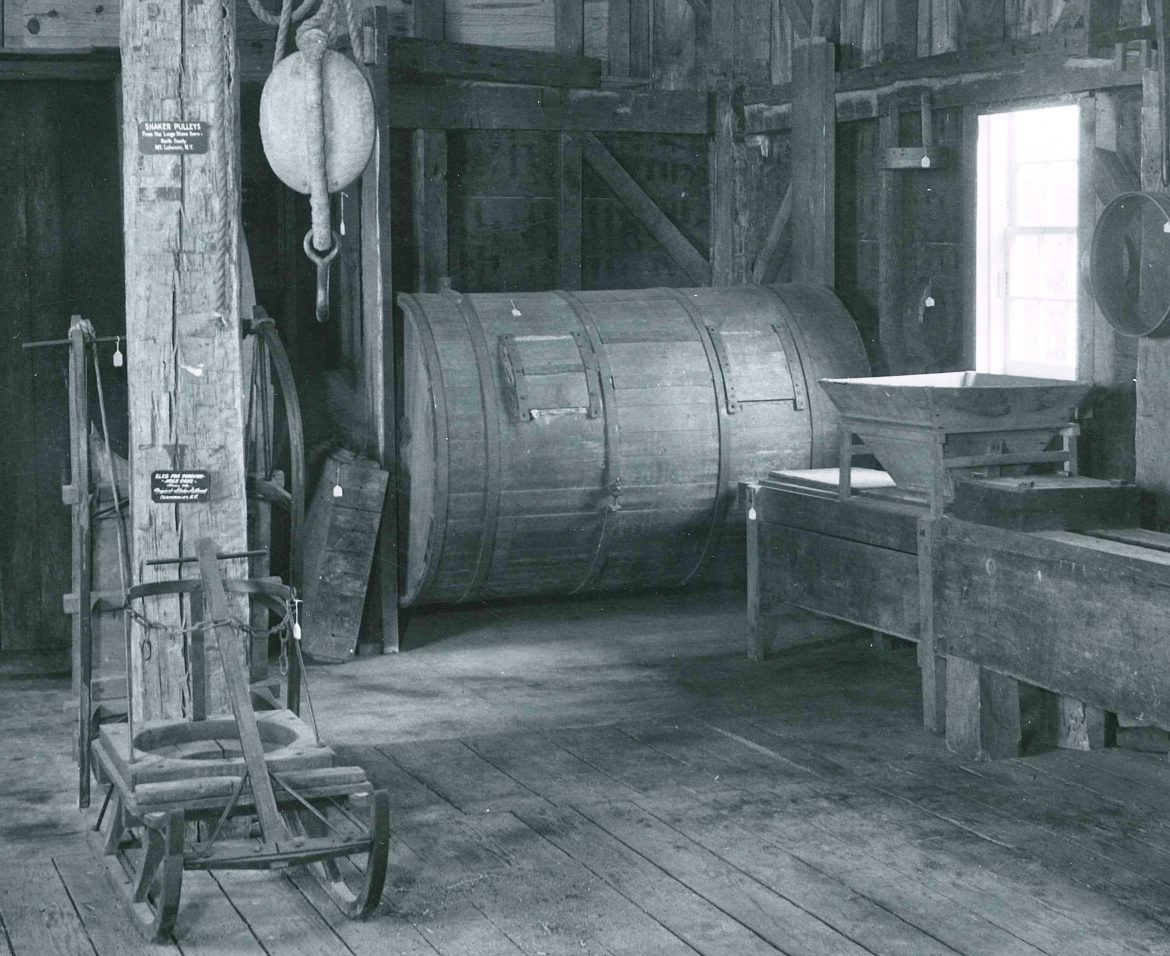
In the early days of the Shaker Museum, when the collection was displayed so that visitors could get “up close” to the collection, as founder John S. Williams desired, occasionally the sound of rolling thunder emerged from one of the galleries. “Someone is playing with the ball mill,” a guide would explain to surprised visitors. The ball mill was […]

Postcard Showing the Ball Mill in the “Seed Department” Exhibit at the Shaker Museum | Mount Lebanon, Ca. 1970. Louis H. Frohman, photographer.
In the early days of the Shaker Museum, when the collection was displayed so that visitors could get “up close” to the collection, as founder John S. Williams desired, occasionally the sound of rolling thunder emerged from one of the galleries. “Someone is playing with the ball mill,” a guide would explain to surprised visitors. The ball mill was a large coopered cylinder, nearly six feet long and four feet in diameter, made of hard maple and mounted horizontally so it could rotate on axles mounted at each end. The cylinder was partitioned in the middle into two equal cylinders in each of which were two cast iron cannon balls. A visitor who decided to see what happened when he or she gave the cylinder a gentle turn were greeted by the crashing sound of the balls rolling against the wood – the thunder.

Cast Iron Ball from Ball Mill, 1830-1850, Shaker Museum | Mount Lebanon: 1950.3353.2. Staff photograph.
The ball mill was made and used by the Hancock Shakers. From physical evidence on the mill itself – marks left on the wood by a rotary planing machine first put in use in the late 1820s and iron screws that were made partly by machine and finished by hand, a characteristic generally dating their manufacture before 1850 – the mill appears to have been made between 1830 and 1850. It was used by the Shakers to crush and grind dried herbs. At one point, several pounds of dried sage were removed from the inside of the cylinder. The Hancock Shakers, apparently in the shadow of the Mount Lebanon’s huge production of herbs and herbal medicines, were not known for growing and processing great quantities of herbal products. One exception seems to have been sage. The ball mill was capable of holding over 23 bushels of dried sage and certainly as it was crushed more and more could have been added. Information recorded at the time the mill was added to the Museum’s collection states, “This machine was used in making powdered sage. The Shakers sold many barrels per month of this to pharmaceutical houses.” Oral history, passed from staff member to staff member at Hancock Shaker Village over the years, suggest that the Hancock Shakers had a steady customer for ground sage from a sausage manufacturer in Pittsfield, Massachusetts. Neither of these statements is substantiated by supporting documentation.

Ball Mill and Brother Ricardo Belden, Hancock, MA, Ca. 1940s, Edward Deming and Faith Andrews Memorial Shaker Collection, Winterthur Museum, Garden & Library: SA1325.8. Retrieved from: http://contentdm.winterthur.org/digital/collection/shaker61/id/693/rec/649.
The ball mill, when at Hancock, was last located on the second floor of the Laundry and Machine Shop – a building that had water-power to operate machinery. A photograph made sometime in the 1940s by an unidentified photographer, now in the Edward Deming and Faith Andrews Memorial Shaker Collection at the Winterthur Museum, Garden & Library, shows the mill in this location. Brother Ricardo Belden is in the photograph apparently explaining how the mill worked. Shaker Museum | Mount Lebanon purchased the ball mill from the Hancock Shakers in March of 1949 and moved it to the Museum, where it has been displayed in several different exhibitions.